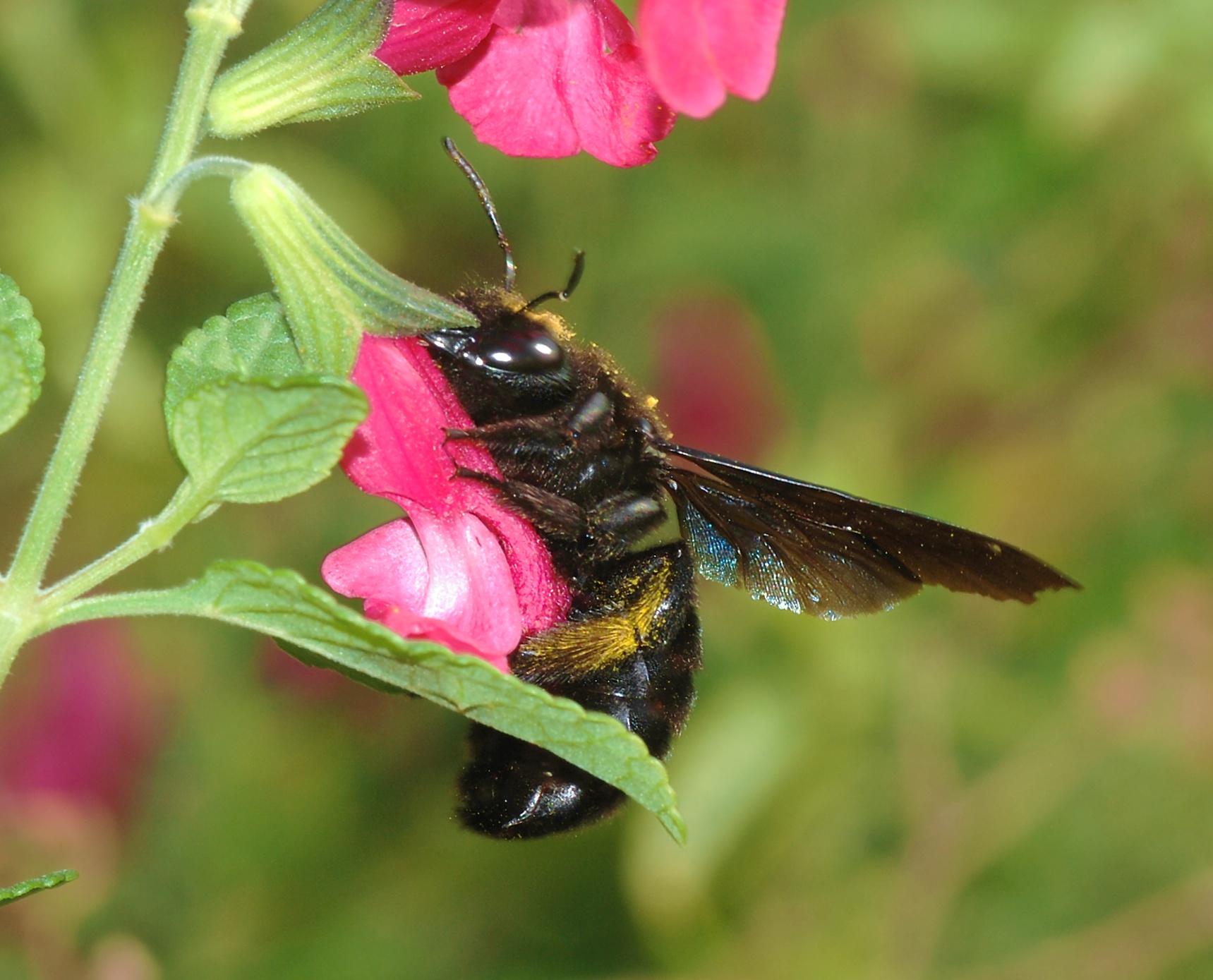- Carpenter bee
image_width = 200px
image_caption = carpenter bee ("X. violacea") robbing nectar
regnum =Animal ia
phylum =Arthropoda
classis =Insecta
ordo =Hymenoptera
subordo =Apocrita
superfamilia =Apoidea
familia =Apidae
subfamilia =Xylocopinae
tribus = Xylocopini
genus = "Xylocopa"
genus_authority =Latreille , 1802
subdivision_ranks = Species
subdivision = see text Carpenter bees (the genus "Xylocopa" in the subfamily Xylocopinae) are large, hairy bees distributed worldwide. There are some 500 species of carpenter bee in 31 subgenera. [Minckley, R.L. 1998. A cladistic analysis and classification of the subgenera and genera of the large carpenter bees, tribe Xylocopini (Hymenoptera: Apidae). Scientific Papers, Natural History Museum, University of Kansas 9:1–47] Their name comes from the fact that nearly all species build their nests in burrows in dead wood, bamboo, or structural timbers (except those in the subgenus "Proxylocopa", which nest in the ground). Members of the related tribeCeratinini are sometimes referred to as "small carpenter bees".Characteristics
In several species, the females live in tunnels alongside their own daughters or sisters, creating a sort of social group. They use wood bits to form partitions between the cells in the nest. A few species bore holes in wood dwellings. Since the tunnels are near the surface, structural damage is generally minor or nonexistent.
Carpenter bees can be important
pollinator s on open-faced flowers, even obligate pollinators on some, such as the Maypop ("Passiflora incarnata "), though many species are also known to "rob"nectar by slitting the sides of flowers with deep corollas.In the
United States , there are two eastern species, "Xylocopa virginica ", and "Xylocopa micans ", and three other species that are primarily western in distribution, one being "Xylocopa varipuncta ". "X. virginica" is by far the more widely distributed species. [ [http://entmuseum.ucr.edu/bug_spotlight/posted%20Images-pages/34.htm We welcome visits to the museum ] ] Some are often mistaken for abumblebee species, as they can be similar in size and coloration, though most carpenter bees have a shiny abdomen, while in bumblebees the abdomen is completely clothed with dense hair. Males of some species have a white or yellow face, where the females do not; males also often have much larger eyes than the females, which relates to their mating behavior. Male bees are often seen hovering near nests, and will approach nearby animals. However, males are harmless since they do not have a stinger [ [http://www.ca.uky.edu/entomology/entfacts/ef611.asp University of Kentucky Entomology: Carpenter Bees] ] . Female bees do have a stinger, but are not aggressive, and will not sting unless directly provoked.Many
Old World carpenter bees have a special pouch-like structure on the inside of their firstmetasoma ltergite called theacarinarium where certain species ofmite s ("Dinogamasus " spp.) reside as commensals. The exact nature of the relationship is not fully understood, though in other bees that carry mites, the mites are beneficial, feeding either onfungi in the nest, or on other, harmful mites.Behavior
Carpenter bees are traditionally considered solitary bees, though some species have simple social nests in which mothers and daughters may cohabit. However, even solitary species tend to be gregarious, and often several will nest near each other. It has been occasionally reported that when females cohabit, there may be a division of labor between them, where one female may spend most of her time as a guard within the nest, motionless and near the entrance, while another female spends most of her time foraging for provisions. Carpenter bees make nests by tunneling into wood, vibrating their bodies as they rasp their mandibles against the wood, each nest having a single entrance which may have many adjacent tunnels. Carpenter bees do not eat wood. They discard the bits of wood, or re-use particles to build partitions between cells. The tunnel functions as a nursery for brood and the pollen/nectar upon which the brood subsists. The provision masses of some species are among the most complex in shape of any group of bees; whereas most bees fill their brood cells with a soupy mass, and others form simple
spheroid al pollen masses, "Xylocopa" form elongate and carefully sculpted masses that have several projections which keep the bulk of the mass from coming into contact with the cell walls, sometimes resembling an irregularcaltrop . The eggs are very large relative to the size of the female, and are some of the largest eggs among all insects. [cite web
title=Chapter 40 — Largest Eggs
url=http://ufbir.ifas.ufl.edu/chap40.htm
author=Salvatore Vicidomini
publisher=University of Florida
date=2005-02-09
work=Book of Insect Records]There are two very different
mating system s that appear to be common in carpenter bees, and often this can be determined simply by examining specimens of the males of any given species. Species in which the males have large eyes are characterized by a mating system where the males either search for females by patrolling, or by hovering and waiting for passing females, whom they then pursue. In the other type of mating system, the males often have very small heads, but there is a large, hypertrophiedgland ular reservoir in themesosoma , which releasespheromone s into the airstream behind the male while it flies or hovers. The pheromone advertises the presence of the male to females. [Minckley, R.L., Buchmann, S.L., Wcislo, W.T. 1991. Bioassay evidence for a sex attractant pheromone in the large carpenter bee, "Xylocopa varipuncta" (Anthophoridae: Hymenoptera). J. Zool. Soc. London 224: 285–291]References
External links
* [http://www.discoverlife.org/mp/20q?guide=Xylocopa United States "Xylocopa" Identification Guide]
* [http://www.discoverlife.org/mp/20q?search=Xylocopa List of Species]
* [http://www.discoverlife.org/mp/20m?kind=Xylocopa_ Worldwide Species Map]
* [http://johnbokma.com/mexit/2006/12/31/the-tame-carpenter-bee.html Close-up photos of a carpenter bee] – taken near the town ofChavarillo ,Veracruz ,Mexico
* [http://creatures.ifas.ufl.edu/misc/bees/xylocopa.htm carpenter bees, "Xylocopa" spp.] on theUF / IFAS Featured Creatures Web site
Wikimedia Foundation. 2010.

